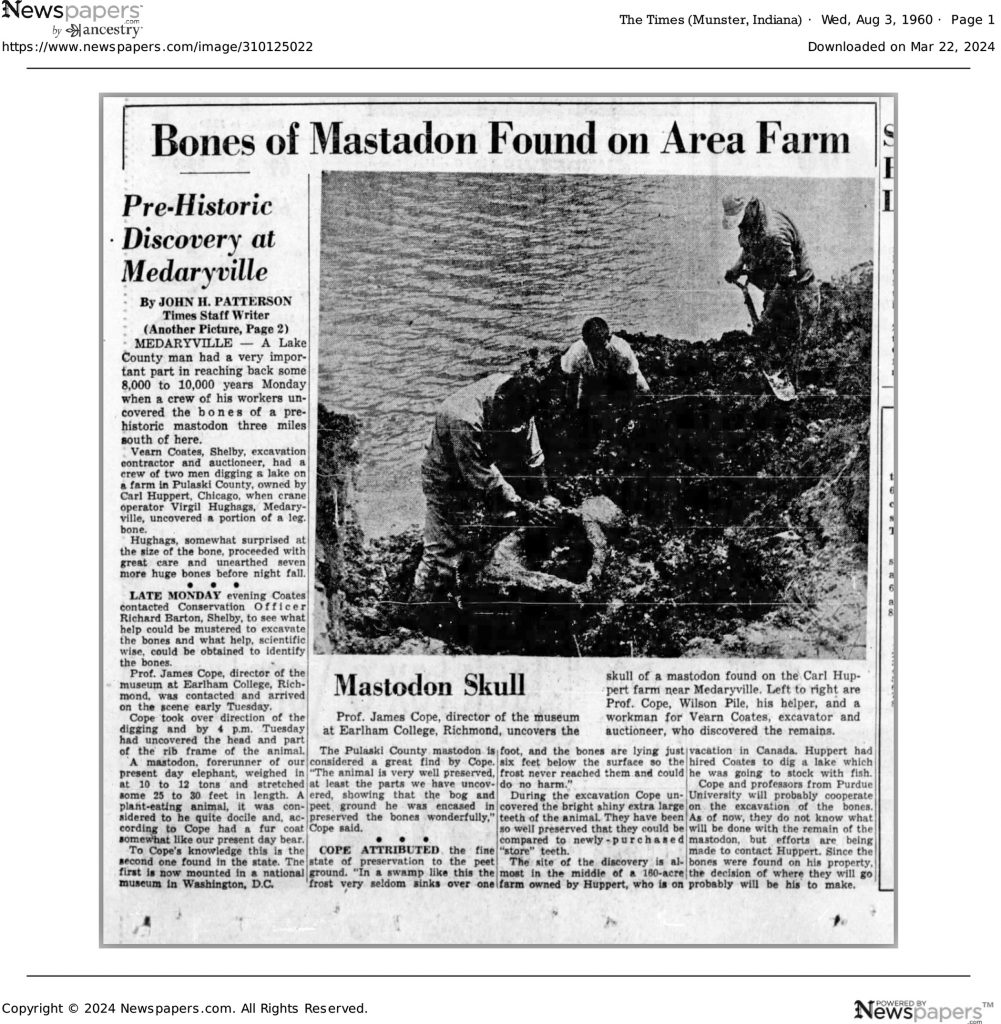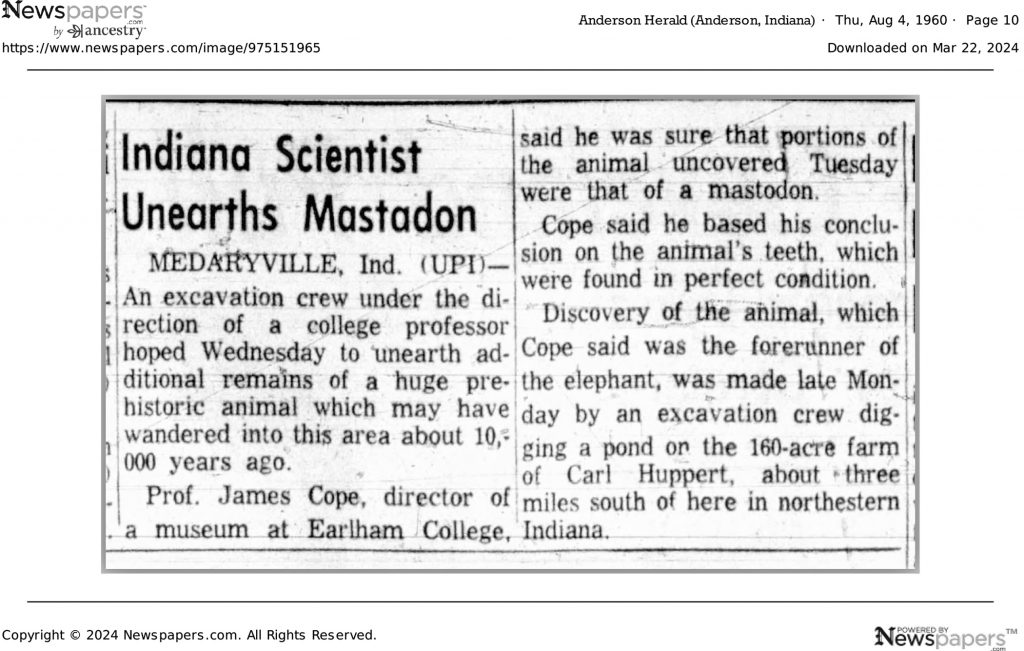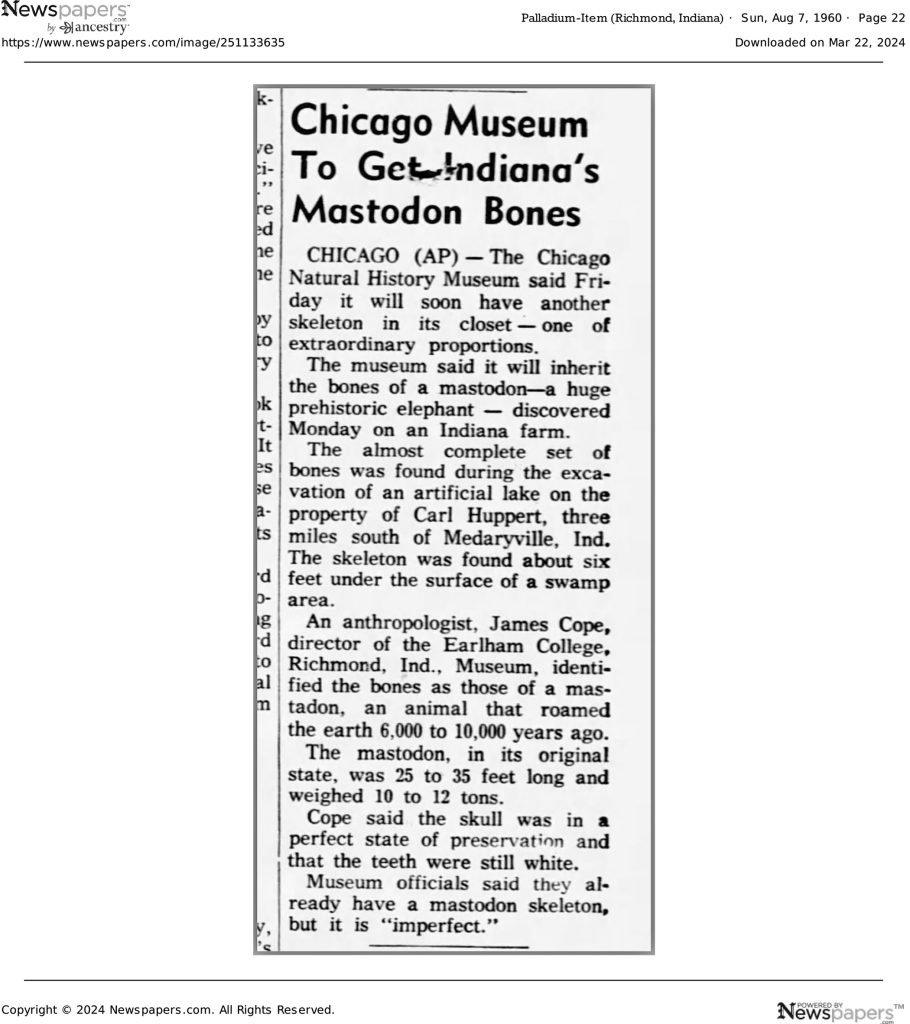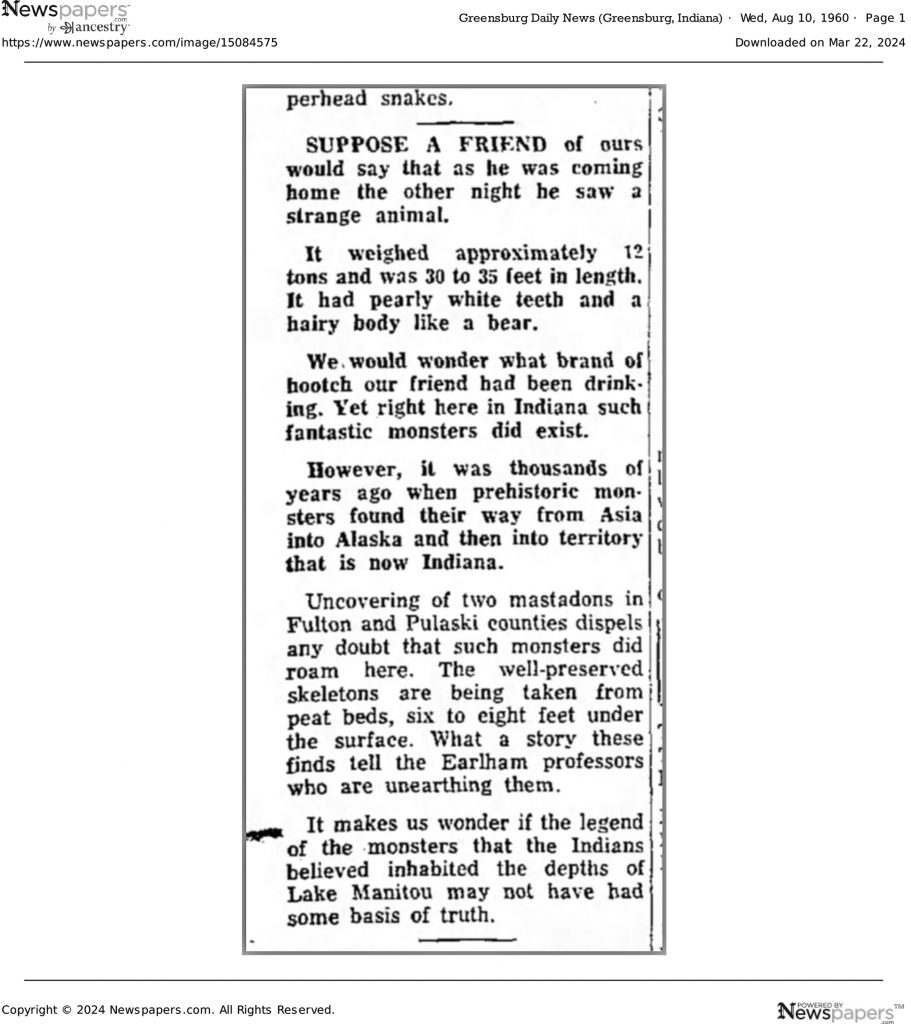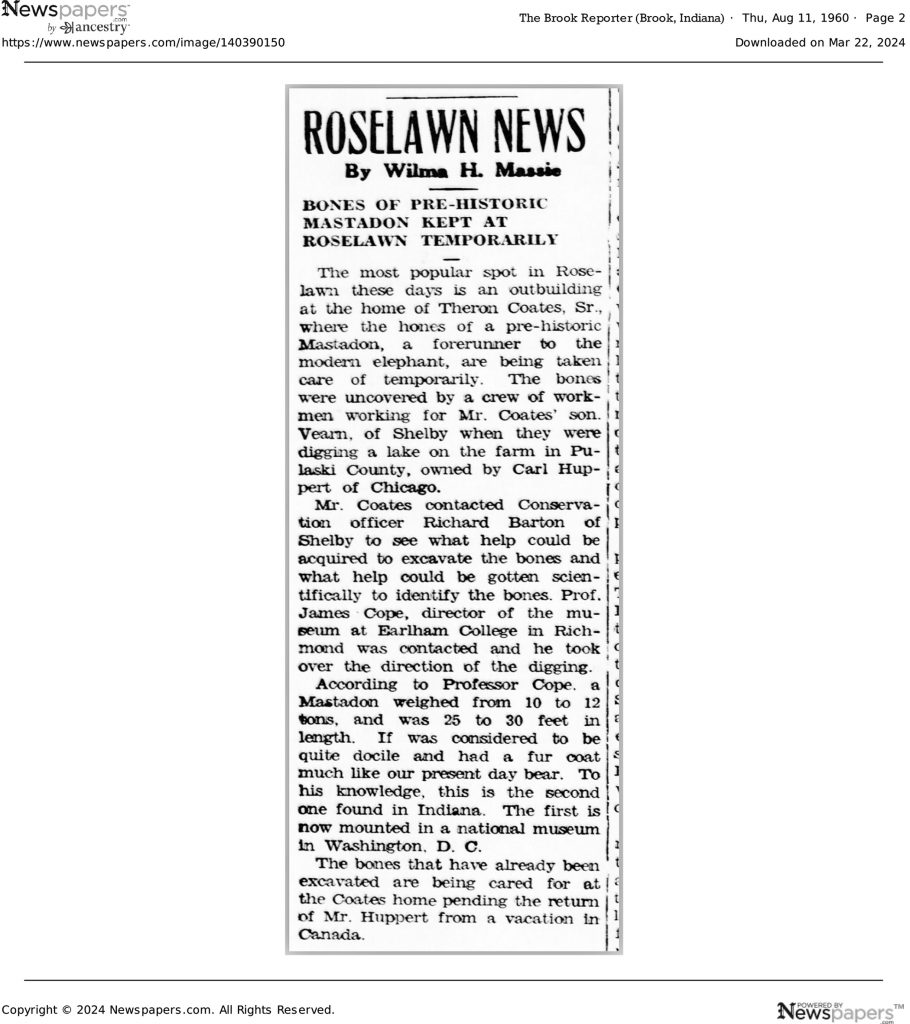Pre-Historic Animal Bones Found Here
** Medaryville Herald Aug 4, 1960
Again Medaryville has come up with the unusual. Last year we had prospector O’Hara and his silver mine. On Monday, August 1, the remains of a mastodon were found. Vearn Coates, auctioneer and excavating contractor from Shelby, had moved his dragline to the Karl H. Huppert farm located about three miles northwest of Medaryville. The farm is better known to the people of Medaryville vicinity as the Ed Luken farm. Mr. Huppert, who lives in Chicago, hired Vearn Coates to dig a fish pond 120 feet wide and 330 feet long on his farm.
Virgil Hughes, Medaryville, who operates the crane for Coates, had been digging the pond during the last two weeks, and Monday afternoon in the process of digging, Hughes dug up some unusually large bones. Hughes, knowing that these were undoubtedly bones from some pre-historic animal, quit digging and notified the conservation authorities.
Digging was resumed Tuesday when James Cope, professor of biology and director of the museum at Earlham College, Richmond. Ind., arrived at the digging site. Many more bones were found, among them was the huge skull, vertebrae, pelvis, shoulder blade, rib bones, and the upper and lower jaw bones with several of the teeth intact.
The rib bones that were found measured about 4 feet straight across from tip to tip and one of the teeth was approximately 3 inches wide and about 8 inches long which would show the enormousness of the remains. Several local residents helped with the excavation, and it took four men to lift the huge skull from its resting place.
The skeleton of this huge animal was discovered in clay three to five feet below the surface of the ground.
Professor Cope states that the bones were preserved due to being in air-tight clay. Professor Cope identified the huge animal as a mastodon, a large elephant-like creature, which fed on vegetation and trees. The mastodon roamed the territory of Indiana before and after the most recent ice age, that being 8 to 10,000 years ago. They ranged in height up to 12 feet in height, were 25 to 30 feet long and would weigh approximately 10 tons.
** Medaryville Herald Aug 4, 1960
Workmen Digging Pond Unearth Mastodon Bones
** Pulaski County Journal Aug 4, 1960
Bones of a pre-historic skeleton were unearthed on the Carl Huppert farm near Medaryville this week, while workmen were engaged in excavating for a farm pond. About three-fourths of the skeletal pieces having been discovered, they were taken to the Jasper-Pulaski game farm, north of Medaryville, watered down and covered with canvas.
A shovel crane unearthed the first portion, a section of the tail, on Monday, in a swampy area of the peat bog. Virgil Hughes, living east of Medaryville, was the crane operator. When the find was made, conservation officers were notified, and Prof. James Cope, director of the Earlham College museum, was called in. Work was then begun trying to unearth the rest of the skeleton.
Prof Cope states that the animal is a mastodon, which probably lived 8,000 to 10,000 years ago, and that the bones are in excellent state of preservation. He explained that the peat and clay-type soil from which they came offers a good protective coating.
The animal’s teeth led to the conclusion that it is a mastodon. They were found in perfect condition. Most of the teeth, still shiny white, were in the skull when it was uncovered Tuesday, but they began to discolor after exposure to air.
Disposition of the skeleton will depend on Mr. Huppert, who is on vacation in Canada. He is a Chicago manufacturer who purchased the farm three miles north of Medaryville several years ago. The family lives in the home only part of the time.
If the complete skeleton is found, it will be Pulaski County’s second mastodon. In 1914, workmen excavating a ditch through a swamp on the W. D. Pattison farm, fifteen miles northwest of Winamac came upon a collection of bones. Mr. Pattison invited an experienced collector from the U. S. National Museum to recover the greater part of the skeleton. That mastodon is now on display in the Smithsonian Institution.
The mastodon, of which several species are known, is related to the elephants. They inhabited the country during the Pleistocene, or Ice Age.
Prof. Cope is directing similar work on the James O. Wells farm, five miles west of Rochester. There, Earlham College students are hand-digging a thirty-foot excavation around the huge animal skeleton. In both instances, the bones were found six or eight feet below the surface of the ground.
Plans Indefinite On Disposition of Mastodon Bones
** Pulaski County Journal Aug 11, 1960
The mastodon bones which were unearthed last week at the Carl Huppert farm near Medaryville have been taken to the home of the excavator, Mr. Coates, at Rose Lawn.
Definite plans for the disposition of the skeletons have not been made, though it has been rumored that a museum will get them. Mr. Huppert, who lives in Chicago, will be at his home at Medaryville this weekend, and a decision will be reached then.
The bones were found while workmen were engaged in excavating for a pond. Prof. James Cope of Earlham College identified them as part of a mastodon. After the first one was dug up, the crane was used to unearth other portions of the skeleton.
The excavation has created wide-spread interest as far away as New York, where the Times carried a story about it.
Mastodon Bones Will Go To Chicago History Museum
*** Pulaski County Journal Aug 25, 1960
The mastodon bones unearthed several weeks ago on a farm near Medaryville will eventually go to the Natural History museum in Chicago, but the contractor who was doing the digging when the bones were discovered is now taking them to fairs for exhibit.
The skeleton, found while workmen were digging a pond on the Carl Huppert farm, northwest of Medaryville, is almost complete. Identification of the bones as those of a mastodon, a large prehistoric animal, was made by Prof. James Cope of Earlham college.
Mastodon Skeleton Going To Chicago
** Medaryville Herald, Aug 11, 1960
The National History Museum will acquire an almost complete set of mastodon bones found last week in a peat bog south (sic) of Medaryville.
Identification of the bones as those of a mastodon, a huge prehistoric animal, was made of Jas. Cope, museum director at Earlham College.
Museum officials in Chicago said they already have an ‘imperfect’ mastodon skeleton.
Mastodon Bones On Display At Fairs
** Medaryville Herald, Aug 25, 1960
The Mastodon bones discovered by Virgil Hughes and his son Paul on the Karl Huppert farm three miles northwest of Medaryville, August 1 were on display at the Jasper County fair at Rensselaer and at Crown Point Aug 22.
Second Mastodon Tusk Unearthed
** Medaryville Herald, July 20, 1961
The Carl Huppert farm, four miles northwest of Medaryville, has given up parts of its second mastodon in a year’s time. Almost a complete skeleton was unearthed during excavation on the farm last summer and Earl Mattocks, who is doing the excavation work there, found another tusk Tuesday.
The latest find is about 125 feet away from the location of the first mastodon, and the diggers think they may find the companion to the other one. The one unearthed last year was given to a Chicago museum.
The tusk broke during the digging process, but the piece bright to Medaryville is about three feet long, six inches in diameter and very heavy. Since exposure to the air turns the bones powdery, Mr. Mattocks is trying to keep this piece under water.
The digging is being done to construct an artificial lake on the farm.
Second Mastodon Tusk Unearthed
** Medaryville Herald, July 20, 1961
The Carl Huppert farm, four miles northwest of Medaryville, has given up parts of its second mastodon in a year’s time. Almost a complete skeleton was unearthed during excavation on the farm last summer and Earl Mattocks, who is doing the excavation work there, found another tusk Tuesday.
The latest find is about 125 feet away from the location of the first mastodon, and the diggers think they may find the companion to the other one. The one unearthed last year was given to a Chicago museum.
The tusk broke during the digging process, but the piece bright to Medaryville is about three feet long, six inches in diameter and very heavy. Since exposure to the air turns the bones powdery, Mr. Mattocks is trying to keep this piece under water.
The digging is being done to construct an artificial lake on the farm.
More Pieces of Tusk Unearthed
** Medaryville Herald, July 27, 1961
Another mastodon tusk was found on the Karl Huppert farm northwest of Medaryville last Friday by Donnie Mattocks, 9-year-old son of Earl Mattocks, who is digging an artificial lake there. The tusk was protruding from the bank, the recent rains having washed away the dirt exposing the tusk. It was 1½ feet deeper than the piece found last week. The largest piece of this tusk was 5 feet long and 10 inches in diameter. Several pieces that had broken off were found.
William Turnbull and Dr. Rainier Zangerl of Chicago came Tuesday and took all the pieces to the Chicago Natural History Museum. Dr. Zangerl thought they were from 9,000 to 12,000 years old, and were probably the tusks of the mastodon skeleton found last year, although they were 125 feet from it. He said the heavy floods at that time could have shifted them.
Copies of Newspaper Articles
Note: Regardless of the articles of the time stating the mastodon was bound for a museum, in 2024, this skeleton has not been located.
